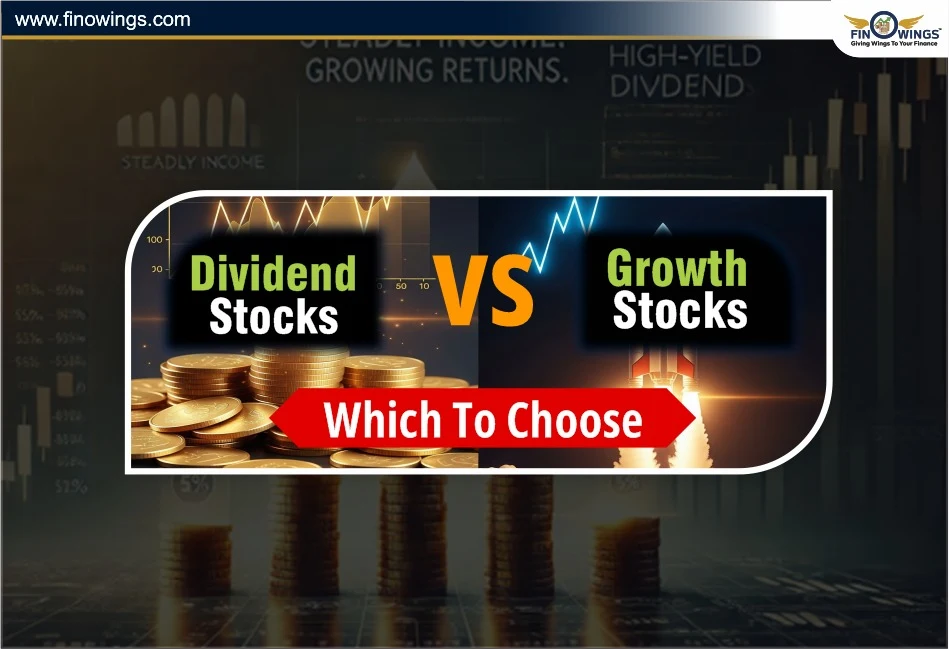Home >> Blog >> Dividend Stocks vs Growth Stocks: Which to Choose?
Dividend Stocks vs Growth Stocks: Which to Choose?

Table of Contents
Dividend Stocks vs Growth Stocks: Which to Choose?
Introduction
Growth stocks in India strive for capital appreciation, whilst dividend stocks in India offer steady income. In this blog, we describe the differences, benefits, and risks, and how to determine which suits your goals.
What Are Dividend Stocks?
Dividend stocks are companies that generate profit and pay cash dividends to shareholders. These companies are usually older with a predictable income stream.
Features of Dividend Stocks
-
Investors enjoy steady cash dividends daily, quarterly, semi-annually, and annually.
-
These companies do not respond sharply to market shifts.
-
Companies are often found in stable capital sectors and mature industries.
-
These companies share wealth through capital appreciation and cash dividends.
Best Dividend Stocks in India: Examples
Here are some top dividend-paying stocks in India:
-
ITC Ltd.
-
Coal India
-
Hindustan Zinc
-
Power Grid Corporation
-
ONGC
These companies maintain a consistent dividend history, making them favourites among conservative investors.
What Are Growth Stocks?
Growth stocks refer to companies that reinvest their profits into business expansion instead of paying dividends. These companies pursue rapid earnings growth, which will lead to stock price appreciation.
Features
-
Most wealth is used for R&D, acquisitions, or expanding capacity.
-
Focusing on wealth creation over the long term.
-
These stocks can be significantly affected by market cycles.
-
These stocks are largely in the tech, pharma, or consumer sectors.
Example of Growth Stocks India
Some of the best growth stocks in India are the following:
-
HDFC Bank
-
Infosys
-
Bajaj Finance
-
Avenue Supermarts (DMart)
-
Titan Company
Dividend Stocks vs Growth Stocks: Key Comparison
|
Parameter |
Dividend Stocks |
Growth Stocks |
|
Primary Goal |
Steady income |
Appreciation of capital |
|
Dividend Payout |
High |
Low or none |
|
Risk Level |
Low to moderate |
Moderate to high |
|
Volatility |
Relatively stable |
More volatile |
|
Ideal For |
Retirees or income-focused investors |
Young investors with long horizons |
|
Tax Treatment |
Dividend income is taxed at the individual rate |
Gains are taxed only upon selling |
|
Reinvestment Strategy |
Limited reinvestment |
Maximum reinvestment for expansion |
When to Choose Dividend Stocks
Choose dividend stocks in India when:
-
You prefer consistent income over high-risk investments.
-
You are at retirement age or need passive income.
-
You want to maintain capital along with a steady income.
-
You are building a balanced portfolio with defensive stocks.
Pro Tip:
-
Optional during long stretches of time, a Dividend Reinvestment Plan (DRIP) allows you to achieve compounding while receiving cash flow from dividends.
-
Indicators for Investing in Growth Stocks
-
Consider investing in growth stocks in India when:
-
You are young and have the appetite for taking higher risks.
-
You want maximised long-term capital gains.
-
You have faith in India's consumption, digital, and infrastructure growth story.
-
You are okay with short-term volatility for higher long-term gains.
Example:
If you invested Rs. 1 lakh in Titan Company back in 2010, today it would be worth Rs. 15 lakh+, and that’s without considering the small dividends it paid. Such growth investing can be powerful.
Dividend stocks, unlike growth stocks, are less volatile and provide stability and regular returns, even in market downtrends.
Combining Both: The Balanced Approach
-
The ideal strategy for most investors remains a mix of both:
-
70% in growth stocks in India for long-term wealth.
-
30% in dividend stocks in India for regular cash flow.
This method guarantees:
-
Monthly dividends, even when the economy isn't doing well.
-
Capital gains over time.
-
Added stability and balance to your overall portfolio.
Potential Risks
|
Risk Type |
Dividend Stocks |
Growth Stocks |
|
Market Risk |
Low |
High |
|
Earnings Risk |
Moderate |
High |
|
Dividend Cuts |
Possible in bad years |
Rare (as no dividends) |
|
Valuation Risk |
Usually fair |
Often overvalued |
Explore top dividend stocks in 2025
Which Should You Choose?
Retired / Conservative Investor - Dividend Stocks
Young / Aggressive Investor - Growth Stocks
Moderate Risk Taker - Mix of Both
Simply put, if you prefer a consistent cash flow, invest in the best dividend-paying stocks in India. For future financial goals, the focus should be on high-quality growth stocks in India. You can also opt for a hybrid portfolio if you wish to enjoy both strategies.
Conclusion
For a balanced portfolio, both dividend stocks and growth stocks are necessary components. It depends on your objectives, age, and how much risk you can handle.
With dividend stocks, you get income and more stability.
With growth stocks, you get compounding and capital appreciation.
In an expanding economy like India, a combination of the two offers consistent cash flow and substantial wealth creation over a long period.
Keep in mind, the finest stocks in India are not exclusively those that pay dividends or rapidly appreciate, but those that match your individual investment plan.
DISCLAIMER: This blog is NOT any buy or sell recommendation. No investment or trading advice is given. The content is purely for educational and information purposes only. Always consult your eligible financial advisor for investment-related decisions.
Author
Frequently Asked Questions
As per Angel One Dividend growth stocks offer better long-term advantages, such as income growth, capital appreciation, and reduced volatility, whilst high yield stocks deliver alluring short-term profits.
Dividend-paying stocks disburse profits on a regular basis, usually on a quarterly basis, whereas growth stocks might need to sell shares in order to realize gains.
The real difference is seen in returns. Over time, direct mutual funds often yield larger returns than their conventional counterparts because of their reduced expense ratios. Growth mutual funds reinvest earnings to increase returns even more.
- The growth option is preferred by those seeking capital gains. However, the Dividend Reinvestment Option would be preferred for investors who place a higher priority on income streams.


















